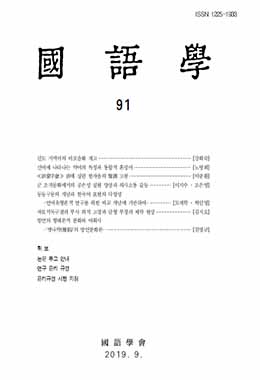범언어적 연구에서 두 지시체의 양적 차이를 비교하는 언어 표현은 차등구문과 동등구문으로 나뉘고, 질적 차이를 견주는 언어 표현은 실제적인 유사구문과 비실제적인 가장구문으로 나뉜다. 본 연구에서는 이 가운데 동등구문의 위상을 검토하고, 언어유형론적인 관점에서 한국어 동등구문의 다양성과 특성을 살펴보았다.
이를 위해 “두 지시체가 같은 등급의 정도를 매길 수 있는 특성을 가지고 있는 상황을 표현하는 것”이라는 동등구문의 비교 개념을 도입하였다. 그리고 동등구문의 분류에 사용할 수 있는 기준을 ‘단일절 對 복합절’, ‘자동문 對 타동문’, ‘종속절 對 병렬절’, ‘동등술어 對 동등정도표지 對 동등기준표지’, ‘개체 연합 對 개체 분리’의 다섯 가지로 정리하였다.
이 기준을 한국어에 적용한 결과 크게 세 가지 유형의 동등구문이 공존하고 있음을 확인할 수 있었다. □ 유형은 단일절, 비타동 구문이고, □ 유형은 단일절, 소유서술어를 사용하는 타동구문이고, □ 유형은 복합절, 종속절 구문이다.
이 유형들은 범언어적으로 발견되는 것들과 유사하다는 점에서 보편성을 드러낸다. 동시에 거의 모든 유형이 주제화가 가능하며, 비교내용이 서술절로 나타나거나 ‘-만큼, -같이’나 ‘-처럼’의 분포가 다양하다는 특징 또한 존재한다. 이는 한국어 동등구문이 갖는 특수성과 다양성을 보여준다는 점에서 의의가 있다.
Linguistic expressions for comparing quantitative differences between two entities can be divided into comparative and equative constructions, but linguistic expressions for comparing qualitative differences can be divided into similative and simulative constructions. We examined the status of equative constructions and searched the diversity and features of the constructions from the typological perspective.
We introduced at first the comparative concept for equative constructions that ‘express situations in which two referents have a gradable property to the same degree’ for the research. Next, we reorganized criteria for the classification of equative constructions and they are ‘mono-clausal vs. bi-clausal,’ ‘intransitive vs. transitive,’ ‘embedding vs. conjoined,’ ‘equative predicate vs. degree marker vs. standard marker,’ ‘unified vs. separate.’
After applying the criteria for Korean, we were able to recognize three types of equative constructions in Korean. Type □ is the mono-clausal and intransitive construction, type □ is the mono-clausal and transitive construction using possessive predicate, and type □ is the bi-clausal and embedding construction. One can divide these types into eight sub-constructions by means of the detail features of each type.
These types reveal typological universals in that they are similar to the types found cross-linguistically. There are also differences like the existence of predicative clauses or the distribution of equative standard markers, and they have some significance because they show the speciality and diversity of equative constructions in Korean.


